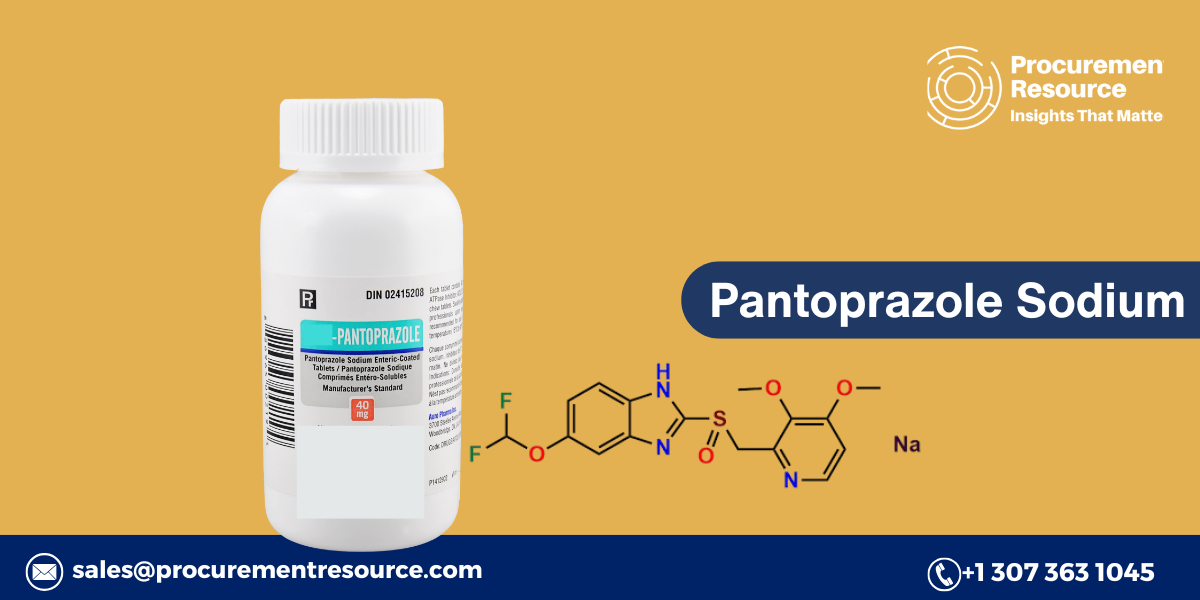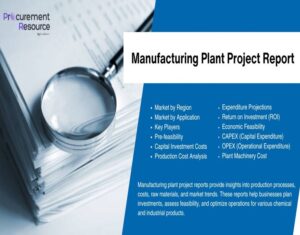
Pantoprazole Sodium Production Process
Understanding the production costs associated with pantoprazole sodium is crucial for pharmaceutical manufacturers, healthcare professionals, and policymakers, as these costs directly impact pricing, accessibility, and market dynamics. This article aims to provide an in-depth analysis of the pantoprazole sodium production cost, examining the various factors that contribute to its overall cost structure. We will discuss raw material prices, manufacturing processes, labor, overhead expenses, regulatory compliance, and market dynamics. Additionally, we will explore historical price trends, current market conditions, and future outlooks for pantoprazole sodium production.
1. Overview of Pantoprazole Sodium
1.1 What is Pantoprazole Sodium?
Pantoprazole sodium is a substituted benzimidazole derivative that is chemically represented as C16H15F2N3O4S·Na. It is typically administered as its sodium salt and is available in both oral and injectable forms. Pantoprazole sodium is often used in the treatment of various gastrointestinal disorders due to its effectiveness in reducing gastric acid secretion. Request For Free Sample: https://www.procurementresource.com/production-cost-report-store/pantoprazole-sodium/request-sample1.2 Importance of Pantoprazole Sodium
Pantoprazole sodium is essential in modern medicine for several reasons:- Efficacy: It provides effective relief from acid-related disorders, improving patients’ quality of life.
- Market Demand: As awareness of acid-related diseases grows, the demand for proton pump inhibitors, including pantoprazole sodium, has increased.
- Pharmaceutical Applications: Its versatility allows it to be used in combination therapies for various gastrointestinal conditions.
2. Historical Production Costs of Pantoprazole Sodium
2.1 Price Trends Over the Last Decade
The production costs of pantoprazole sodium have experienced fluctuations over the past decade, influenced by various factors:- 2010-2014: During this period, the prices were relatively stable, with moderate increases attributed to growing demand for PPIs. The pharmaceutical industry experienced steady growth, positively impacting production costs.
- 2015-2017: Prices began to rise significantly due to an increase in raw material costs and regulatory pressures on pharmaceutical manufacturers. Competition in the PPI market also influenced pricing strategies.
- 2018-2019: The market saw some stabilization in prices as manufacturers optimized their production processes and raw material sourcing.
- 2020-Present: The COVID-19 pandemic caused disruptions in supply chains and production capacities, leading to price volatility. However, as healthcare systems adjusted to the new normal, demand for pantoprazole sodium rebounded, influencing pricing trends.
2.2 Recent Price Movements
In recent months, the prices of pantoprazole sodium have shown notable variability:- Supply Chain Disruptions: Ongoing challenges in global logistics and raw material procurement have affected availability and pricing.
- Raw Material Costs: Fluctuations in the prices of key raw materials used in the production of pantoprazole sodium, such as specific intermediates and solvents, have impacted overall production costs.
- Market Demand: Increased demand for pantoprazole sodium, particularly due to rising gastrointestinal disorders, has exerted upward pressure on prices.
3. Factors Influencing Pantoprazole Sodium Production Costs
3.1 Raw Material Costs
The cost of raw materials plays a critical role in the overall production cost of pantoprazole sodium:- Key Ingredients: The production of pantoprazole sodium requires specific intermediates, including 2-[(2,2-difluoro-1-methylethyl) sulfinyl] and other chemical compounds. The prices of these raw materials can fluctuate based on market conditions and availability.
- Solvents and Reagents: Various solvents and reagents used in the synthesis process also contribute to raw material costs. The prices of these chemicals can be influenced by supply chain dynamics and global market trends.
3.2 Manufacturing Process
The manufacturing process for pantoprazole sodium involves several key steps that impact production costs:- Synthesis: The production process typically includes multiple reaction steps, such as sulfonation, substitution, and crystallization. The efficiency of these reactions can significantly influence overall production costs.
- Purification: After synthesis, pantoprazole sodium undergoes purification processes to remove impurities and by-products. The methods used for purification, such as recrystallization or chromatography, can add to the production expenses.
- Yield and Efficiency: The yield of pantoprazole sodium produced in each batch and the efficiency of the manufacturing process are critical factors in determining production costs. High yields and efficient processes can lead to lower costs.
3.3 Labor and Overhead Costs
Labor costs are a significant component of the overall production expenses:- Skilled Labor: The synthesis of pantoprazole sodium requires skilled personnel to monitor the production processes and ensure compliance with safety regulations. Labor costs can vary based on the location and labor market conditions.
- Overhead Expenses: Overhead costs, such as facility maintenance, utilities, and equipment depreciation, also contribute to the overall production costs.
3.4 Regulatory Compliance
Compliance with regulatory standards can significantly influence production costs:- Quality Assurance: Pharmaceutical manufacturers must adhere to stringent quality control measures, which can require investments in testing and validation processes, increasing production costs.
- Environmental Regulations: Compliance with environmental regulations regarding emissions and waste management may necessitate additional investments in technology and processes, further impacting production costs.
3.5 Market Dynamics
Market conditions can significantly influence the pricing and production costs of pantoprazole sodium:- Global Demand: Changes in demand from key markets, particularly in the healthcare and pharmaceutical sectors, can affect pricing and production levels.
- Competition: Competitive pressures in the PPI market can impact pricing strategies for pantoprazole sodium, influencing profitability for manufacturers.
- Economic Conditions: Economic fluctuations can influence demand for pantoprazole sodium and raw materials, affecting overall pricing dynamics.
4. Current Market Dynamics
4.1 Major Producers of Pantoprazole Sodium
Several companies are key players in the production of pantoprazole sodium:- Pharmaceutical Companies: Large pharmaceutical firms often have integrated operations to optimize production and maintain competitive pricing in the market.
- Contract Manufacturers: Many companies outsource the production of pantoprazole sodium to contract manufacturers specializing in chemical synthesis and pharmaceutical production.
4.2 Consumption Trends
The demand for pantoprazole sodium is influenced by various factors:- Healthcare Needs: The rising prevalence of gastrointestinal disorders, such as GERD, is driving the demand for pantoprazole sodium in the healthcare sector.
- Pharmaceutical Market Growth: The growth of the pharmaceutical market, particularly in developing countries, contributes to increased consumption of pantoprazole sodium.
4.3 Price Differentiation
Prices for pantoprazole sodium can vary based on several factors:- Quality and Purity: Higher purity pantoprazole sodium may command a premium price, especially for specialized pharmaceutical applications.
- Regional Pricing Variations: Factors such as local supply and demand dynamics, transportation costs, and regulatory requirements can create price differentials across markets.
5. Future Outlook for Pantoprazole Sodium Prices
5.1 Anticipated Demand Growth
The demand for pantoprazole sodium is expected to rise in the coming years:- Increasing Awareness: As awareness of gastrointestinal disorders increases, more patients are likely to seek treatment, boosting demand for pantoprazole sodium.
- Aging Population: The growing elderly population, who are more susceptible to acid-related disorders, will further drive demand for effective medications like pantoprazole sodium.
5.2 Technological Advancements
Future developments in production technology may impact costs:- Enhanced Production Techniques: Innovations in chemical production methods may improve efficiency and reduce costs, thereby influencing market pricing for pantoprazole sodium.
- Sustainable Practices: The rising focus on green chemistry and sustainable manufacturing practices may lead to the development of environmentally friendly production methods, impacting supply dynamics and pricing.
5.3 Regulatory Developments
Changes in regulations governing pharmaceutical production may influence pricing:- Quality Control Standards: Stricter quality control measures may increase production costs, impacting the market price for pantoprazole sodium.
- Trade Policy Adjustments: Changes in trade agreements can affect market access and pricing strategies for pantoprazole sodium exports.






